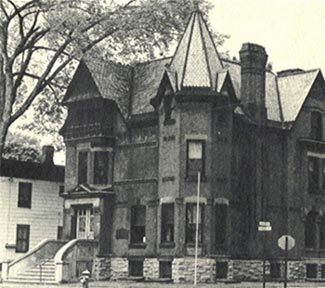HISTORIC HOMES OF HERKIMER COUNTY
HISTORIC LOCATIONS of the VILLAGE

The article below appeared in "The Evening Telegram" on March 15, 1930. All
punctuation, capitalization, etc. is exactly the same as the newsprint. This editor has
included above a picture of the Suiter Building which many will recognize as the building
used for many years as the main building of the Herkimer County Historical Society.
Betsy Voorhees
Town of Herkimer Editor
THIS VILLAGE ABOUNDS IN MANY
HISTORIC SITES AND ROMANCES
OF EARLY DAYS OF THE NATION
Travelers Can find Here a Plethora of Old Landmarks and
Sites of Buildings Linked With the Early History of the
American Republic -- A Few of Them
Few communities have such a wealth of historic romance and such an abundance of historical sites as does Herkimer, and tourists may spend many interesting hours visiting them, as the Telegram will tell in a series of articles.
Founded as an outpost of civilization in those distant years when the pioneers, with hardy hands were invading the virgin wilderness of the North American continent, Herkimer was the scene of many historic events, which are well worth the chronicling pen of a Ridpath or some other master writer of world history.
There are many historic sites and buildings which should be viewed by every tourist.
For instance, there is the old Reformed church, located on its original site, at the corner of Church and North Main streets--just where its predecessors stood, although the hands of invading Indian and tories levelled it during the raids of the later Revolutionary War period, and fire wiped it out again some years later.
This old edifice was originally built by the Palatines in 1730, on an acre of land given by Johann Jost Petry. In November of 1757 it was destroyed when Indians under M. Beletre burned this village. Later, in 1804, another church was built on the site, which, in turn was burned, with the court house and jail, in 1834, and the present one erected immediately.
The Huyck block, corner of Main and Park avenue, is the site of the law office of Michael Hoffman, Democrat member of congress in 1825 to 1833. Jefferson Davis, president of the ill-starred Confederate States of America, was Hoffman's guest in 1835, long before he dreamed of seceding from the Union and becoming head of the rebel government.
On North Washington street was located the first school in this village, near the Folts residence.
The home of Gaylord Griswold, only lawyer here in 1795 and member of congress in 1802, was located on North Main street, where Christ Episcopal church now stands.
Governor George Clinton built a beautiful colonial mansion for his daughter, Mrs. Philo Hackley, in 1802, near the end of North Main street, and went from here to start building the Erie canal in 1825.
On the site of the First National Bank, but on the Green street side, was located in 1810-1831 the printing office of the Herkimer-American, with Edward P. Seymour as editor.
The Charles Munger home on German street was the location of the home of Major General Michael Myers, who bought it from Hanjost and Deferick Petry, whose father, Johann Jost Petry, had received it in royal grant from the crown at lots 8 and 17 of the Burnetsfield Patent, prior to the Revolution.
Also about the middle of German street, was the Colonel Peter Weber house, built in 1807. And in its rear, was the well from which Fort Dayton used to get its water supply.
The old Fort Dayton was located on a little knoll just north of the present county clerk's office, and was the outpost for many years, during the Revolutionary days, for the American armies, withstanding many a raid and sending out many an expedition to harrass the enemy.The most notable historical associations of old Fort Dayton were the assembling of General Herkimer's army on the way to the bloody field of Oriskany on that August day of 1777, and the visit of George Washington in 1783, when he made it his base of supply for the western army.
The old Barnum Tavern, where stages used to stop, was located in 1800, on upper North Main street near the court house, and, at the head of Main street, in 1807, was located the home of Colonel Peter Weaver, Colonist warrior.
At the corner of Mohawk street and Dewey avenue was located the home of Dominie Spinner, father of General Spinner, who was treasury head under Abraham Lincoln. Dominie Spinner was instrumental in enlarging the old Fort Herkimer church.A statue of General Spinner stands in Myers park.
On German street, just west of Main street, on the propery now owned by A. T. Smith, was situated the home of King Weber in 1775, also the site of an Indian trading post in 1770.
And, on the same street nearby, in 1866 was located the birthplace of Colonel Suiter.
These are only a few of the more ancient landmarks of this village.
With such historic memories, is it any wonder that the village is proud of its long and honorable history?